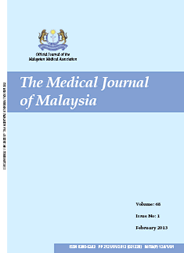MJM, Vol 70 Supplement 1 September 2015
Prevalence of overweight/obesity and its associated
factors among secondary school students in Batang Padang District, Perak
*Department of Community Health, Faculty of Medicine and Health Sciences, Universiti Putra Malaysia, **Department of Nutrition and Dietetics, Faculty of Medicine and Health Sciences, Universiti Putra Malaysia, ***Department of Medicine, Faculty of Medicine and Health Sciences, Universiti Putra Malaysia
ABSTRACT
Introduction: Overweight and obese adolescents are at increased risk of significant health problems such as hypertension, diabetes, heart disease, stroke and cancer. The objective of this study is to determine the prevalence and predictors of overweight and obesity among secondary school students.
Materials and Methods: A cross-sectional study was conducted in 10 selected secondary schools in Batang Padang district, Perak, Malaysia. A validated self-administered questionnaire was used to obtain information on sociodemographic, lifestyle and psychosocial factors. General physical activity (Physical activity questionnaire for adolescents (PAQ-A)), self-esteem (Rosenberg self-esteem Scale), body image (body parts satisfaction and body size perception scale) were also assessed. Height and weight were measured, and body mass index (BMI, kg/m2) were calculated. Univariate logistic regression was used to determine the crude odd ratio. Variables with p value < 0.25 were entered into the multivariable logistic regression to determine the adjusted odd ratio.
Results: The overall response rate was 86%. Majority of the 6515 respondents were females (52.1%), Malays (55.6%) and Muslims (56.2%). The mean age was 15.02 ± 1.42 years. The overall prevalence of overweight and obesity was 15.0% and 12.3% respectively. Majority (79.8%) of the respondents have low physical activity level. Multiple logistic regression showed that the significant predictors of overweight/obesity were gender (male adjusted Odds Ratio (aOR) 1.48, 95%CI: 1.31-1.67), ethnicity compared to Indians (Malays aOR 1.15, 95%CI: 0.96-1.38; Chinese aOR 0.77, 95%CI: 0.63-0.94, Others aOR 0.60, 95% CI: 0.43-0.82), compared to high physical activity (low physical activity aOR 1.28, 95%CI: 1.10-1.50), satisfied with body parts (dissatisfied aOR 1.92, 95%CI%: 1.68-2.20), satisfied with body perception (dissatisfied aOR 4.53, 95%CI: 3.83-5.34).
Conclusions: The overall prevalence of overweight and obesity was high. The findings from this study can be used by policy makers to plan an integrated intervention program to tackle the increasing prevalence of obesity.
Key Words: Adolescents, Obesity, Prevalence, Predictors
